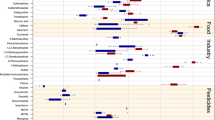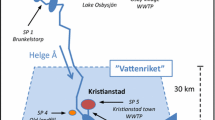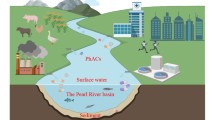Abstract
This study evaluated the impact of secondary municipal effluent discharge on carbamazepine, diclofenac, and metoprolol concentrations in small and medium rivers in northern Germany and compared the measured environmental concentrations (MECs) to the predicted environmental concentrations (PECs) calculated with four well-established models. During a 1-year sampling period, secondary effluent grab samples were collected at four wastewater treatment plants (WWTPs) together with grab samples from the receiving waters upstream and downstream from the wastewater discharge points. The carbamazepine, diclofenac, and metoprolol concentrations were analyzed with high-performance liquid chromatography-tandem mass spectrometry (HPLC/MS-MS) after solid phase extraction. In the secondary effluents, 84–790 ng/L carbamazepine, 395–2100 ng/L diclofenac, and 745–5000 ng/L metoprolol were detected. The carbamazepine, diclofenac, and metoprolol concentrations analyzed in the rivers downstream from the secondary effluent discharge sites ranged from <5 to 68, 370, and 520 ng/L, respectively. Most of the downstream pharmaceutical concentrations were markedly higher than the corresponding upstream concentrations. The impact of wastewater discharge on the MECs in rivers downstream from the WWTPs was clearly demonstrated, but the correlations of the MECs with dilution factors were poor. The smallest rivers exhibited the largest maximum MECs and the widest ranges of MECs downstream from the wastewater discharge point. Three of the four tested models were conservative, as they showed higher PECs than the MECs in the rivers downstream from the WWTPs. However, the most detailed model underestimated the diclofenac concentrations.






Similar content being viewed by others
References
Baselt, R. C. (2004). Disposition of toxic drugs and chemicals in man (7th ed.). Foster City: Biomedical.
Brunton, L., Lazo, J., & Parker, K. (Eds.) (2006). Goodman & Gilman’s the pharmacological basis of therapeutics (11th ed.). New York, NY: McGraw-Hill.
Buser, H.-R., Poiger, T., & Müller, M. D. (1998). Occurrence and fate of the pharmaceutical drug diclofenac in surface waters: rapid photodegradation in a lake. Environmental Science and Technology, 32(22), 3449–3456.
Celle-Jeanton, H., Schemberg, D., Mohammed, N., Huneau, F., Bertrand, G., Lavastre, V., & Le Coustumer, P. (2014). Evaluation of pharmaceuticals in surface water: reliability of PECs compared to MECs. Environment International, 73, 10–21. doi:10.1016/j.envint.2014.06.015.
Choi, K., Kim, Y., Park, J., Park, C. K., Kim, M. Y., Kim, H. S., & Kim, P. (2008). Seasonal variations of several pharmaceutical residues in surface water and sewage treatment plants of Han River, Korea. Science of the Total Environment, 405(1–3), 120–128.
Clara, M., Strenn, B., Gans, O., Martinez, E., Kreuzinger, N., & Kroiss, H. (2005). Removal of selected pharmaceuticals, fragrances and endocrine disrupting compounds in a membrane bioreactor and conventional wastewater treatment plants. Water Research, 39(19), 4797–4807.
Coetsier, C. M., Spinelli, S., Lin, L., Roig, B., & Touraud, E. (2009). Discharge of pharmaceutical products (PPs) through a conventional biological sewage treatment plant: MECs vs PECs? Environment International, 35(5), 787–792. doi:10.1016/j.envint.2009.01.008.
Eilers, J. (1990). Zur Berechnung offener Gerinne mit beweglicher Sohle und Uferbewuchs. Mitteilungen aus dem Leichtweiß-Institut für Wasserbau 106, Braunschweig, Germany.
EMA. (2006). Guideline on the environmental risk assessment of medicinal products for human use. Doc. Ref. EMEA/CHMP/SWP/4447/00 corr 2*. European Medicines Agency, London. http://www.ema.europa.eu/docs/en_GB/document_library/Scientific_guideline/2009/10/WC500003978.pdf. Accessed 03 Jul 2016.
EMEA/CPMP. (2001). The European Agency for the Evaluation of Medicinal Products—evaluation of medicines for human use (Committee for Proprietary Medicinal Products). Discussion paper on environmental risk assessment of nongenetically modified organism (non-GMO) containing medicinal products for human use. CPMP/SWP/4447/00 draft corr.
Engel, N., Hübsch, L., & Müller, U. (2014). Beregnungsbedarfsermittlung und Beregnungssteuerung als Anpassungsmaßnahme an den Klimawandel. Wasser und Abfall, 16(6), 10–14.
European Commission. (2000). Directive 2000/60/EC of the European Parliament and of the Council of 23 October 2000 establishing a framework for Community action in the field of water policy. http://eur-lex.europa.eu/legal-content/EN/TXT/PDF/?uri=CELEX:02000L0060-20140101&from=EN. Accessed 03 Jul 2016.
Franquet-Griell, H., Gómez-Canela, C., Ventura, F., & Lacorte, S. (2015). Predicting concentrations of cytostatic drugs in sewage effluents and surface waters of Catalonia (NE Spain). Environmental Research, 138, 161–172. doi:10.1016/j.envres.2015.02.015.
Gerbersdorf, S. U., Cimatoribus, C., Class, H., Engesser, K.-H., Helbich, S., Hollert, H., Lange, C., Kranert, M., Metzger, J., Nowak, W., Seiler, T.-B., Steger, K., Steinmetz, H., & Wieprecht, S. (2015). Anthropogenic trace compounds (ATCs) in aquatic habitats—research needs on sources, fate, detection and toxicity to ensure timely elimination strategies and risk management. Environment International, 79, 85–105.
Gerrity, D., Trenhol, R. A., & Snyder, S. A. (2011). Temporal variability of pharmaceuticals and illicit drugs in wastewater and the effects of a major sporting event. Water Research, 45(17), 5399–5411.
Heberer, T., & Feldmann, D. (2005). Contribution of effluents from hospitals and private households to the total loads of diclofenac and carbamazepine in municipal sewage effluents—modeling versus measurements. Journal of Hazardous Materials, 122(3), 211–218.
Henschel, K. P., Wenzel, A., Diedrich, M., & Fliedner, A. (1997). Environmental hazard assessment of pharmaceuticals. Regulatory Toxicology and Pharmacology, 25(3), 220–225.
Heß, O. (2003). Analyse und Bewertung des chemischen Gewässerzustandes in Flussgebieten. Dissertation, Osnabrück University, Germany.
Jirka, G. H., & Lang, C. (2009). Einführung in die Gerinnehydraulik. Karlsruhe, Germany: Universitätsverlag Karlsruhe. http://digbib.ubka.uni-karlsruhe.de/volltexte/1000011374. Accessed 03 Jul 2016.
Klepiszewski, K., Venditti, S., & Koehler, C. (2016). Tracer tests and uncertainty propagation to design monitoring setups in view of pharmaceutical mass flow analyses in sewer systems. Water Research, 98, 319–325.
LANUV NRW. (Ed.). (2007). Eintrag von Arzneimitteln und deren Verhalten und Verbleib in der Umwelt—Literaturstudie. LANUV-Fachbericht 2. Recklinghausen, Germany: Landesamt für Natur, Umwelt und Verbraucherschutz Nordrhein-Westfalen (The North Rhine-Westphalia State Environment Agency).
Liebig, M., Moltmann, J. F., & Knacker, T. (2006). Evaluation of measured and predicted environmental concentrations of selected human pharmaceuticals and personal care products. Environmental Science and Pollution Research, 13(2), 110–119.
López-Serna, R., Petrović, M., & Barceló, D. (2012). Occurrence and distribution of multi-class pharmaceuticals and their active metabolites and transformation products in the Ebro River basin (NE Spain). Science of the Total Environment, 440, 280–289.
LUBW. (Ed.). (2014). Spurenstoffinventar der Fließgewässer in Baden-Württemberg. Landesanstalt für Umwelt, Messungen und Naturschutz Baden-Württemberg, Karlsruhe, Germany. http://www4.lubw.baden-wuerttemberg.de/servlet/is/243039/. Accessed 03 Jul 2016.
Meinke, I., Weiße, R., & von Storch, H. (2011). Regionale Klimaszenarien in der Praxis. Beispiel Metropolregion Hamburg. Geesthacht, Germany: Helmholtz-Zentrum. http://www.hzg.de/imperia/md/content/klimabuero/publikationen/factsheet_hamburg.pdf. Accessed 03 Jul 2016.
Moreno-González, R., Rodríguez-Mozaz, S., Gros, M., Pérez-Cánovas, E., Barceló, D., & León, V. M. (2014). Input of pharmaceuticals through coastal surface watercourses into a Mediterranean lagoon (Mar Menor, SE Spain): sources and seasonal variations. Science of the Total Environment, 490, 59–72.
Mutschler, E., Geisslinger, G., Kroemer, H. K., Ruth, P., & Schäfer-Korting, M. (2001). Arzneimittelwirkungen: Lehrbuch der Pharmakologie und Toxikologie (8th ed.). Stuttgart: Wissenschaftliche Verlagsanstalt.
Nakada, N., Komori, K., Suzuki, Y., Konishi, C., Houwa, I., & Tanaka, H. (2007). Occurrence of 70 pharmaceutical and personal care products in Tone River basin in Japan. Water Science and Technology, 56(12), 133–140.
NAW. (2010). General information (group A)—part 15: sampling from running waters (A15) (in German). In German standard methods for the examination of water, waste water and sludge. Ed. Normenausschuss Wasserwesen (NAW) im DIN. Berlin: DIN Deutsches Institut für Normung e.V.
Nelson, E. D., Do, H., Lewis, R. S., & Carr, S. A. (2011). Diurnal variability of pharmaceutical, personal care product, estrogen and alkylphenol concentrations in effluent from a tertiary wastewater treatment facility. Environmental Science and Technology, 45(4), 1228–1234.
NLWKN. (2011). Die Beseitigung kommunaler Abwässer in Niedersachsen—Lagebericht 2011 gemäß Artikel 16 der EU-Richtlinie über die Behandlung von kommunalem Abwasser (91/271/EWG). Hildesheim, Germany: Niedersächsischer Landesbetrieb für Wasserwirtschaft, Küsten- und Naturschutz.
Nödler, K., Licha, T., Fischer, S., Wagner, B., & Sauter, M. (2011). A case study on the correlation of micro-contaminants and potassium in the Leine River (Germany). Applied Geochemistry, 26(12), 2172–2180.
Osorio, V., Marcé, R., Pérez, S., Ginebrada, A., Cortina, J. L., & Baceló, D. (2012a). Occurrence and modeling of pharmaceuticals on a sewage-impacted Mediterranean river and their dynamics under different hydrological conditions. Science of the Total Environment, 440, 3–13.
Osorio, V., Pérez, S., Ginebreda, A., & Barceló, D. (2012b). Pharmaceuticals on a sewage impacted section of a Mediterranean River (Llobregat River, NE Spain) and their relationship with hydrological conditions. Environmental Science and Pollution Research, 19, 1013–1025.
Paxeus, N. (2004). Removal of selected non-steroidal anti-inflammatory drugs (NSAIDs), gemfibrozil, carbamazepine, beta-blockers, trimethoprim and triclosan in conventional wastewater treatment plants in five EU countries and their discharge to the aquatic environment. Water Science and Technology, 50(5), 253–260.
Radjenović, J., Petro Radjenović, M., & Barceló, D. (2007). Advanced mass spectrometric methods applied to the study of fate and removal of pharmaceuticals in wastewater treatment. TrAC Trends in Analytical Chemistry, 26(11), 1132–1144.
Riva, F., Zuccato, E., & Castiglioni, S. (2015). Prioritization and analysis of pharmaceuticals for human use contaminating the aquatic ecosystem in Italy. Journal of Pharmaceutical and Biomedical Analysis, 106, 71–78.
R Project. (2016). R version 3.3.0 (Supposedly Educational) https://www.r-project.org/. Accessed 03 Jul 2016.
Sacher, F., Ehmann, M., Gabriel, S., Graf, C., & Brauch, H.-J. (2008). Pharmaceutical residues in the river Rhine—results of a one-decade monitoring programme. Journal of Environmental Monitoring, 10(5), 664–670.
Schwabe, U., & Paffrath, D. (Eds.) (2011). Arzneiverordnungs-Report 2011. Aktuelle Daten, Kosten, Trends und Kommentare. Berlin: Springer.
SRU. (2007). Pharmaceuticals in the environment. Berlin: Sachverständigenrat für Umweltfragen (The German Advisory Council on the Environment). http://www.umweltrat.de/SharedDocs/Downloads/EN/04_Statements/2007_Statement_12_Pharmaceuticals_Environment.pdf?__blob=publicationFile. Accessed 03 Jul 2016.
Statistisches Bundesamt. (2013). Statistisches Jahrbuch—Deutschland und Internationales. Wiesbaden. https://www.destatis.de/DE/Publikationen/StatistischesJahrbuch/StatistischesJahrbuch2013.pdf?__blob=publicationFile. Accessed 03 Jul 2016.
Stuer-Lauridsen, F., Birkved, M., Hansen, L. P., Lützhøft, H. C., & Halling-Sørensen, B. (2000). Environmental risk assessment of human pharmaceuticals in Denmark after normal therapeutic use. Chemosphere, 40(7), 783–793.
Ternes, T. (1998). Occurrence of drugs in German sewage treatment plants and rivers. Water Research, 32(11), 3245–3260.
UNEP. (2015). Implementation towards the achievement of the 2020 goal of sound chemicals management: emerging policy issues and other issues of concern: proposal on environmentally persistent pharmaceutical pollutants as a new emerging policy issue. http://www.saicm.org/images/saicm_documents/iccm/ICCM4/Advance/K1502367%20SAICM%20ICCM%204-7%20-%20Advance.pdf. Accessed 03 Jul 2016.
Verlicchi, P., Al Aukidy, M., Jelic, A., Petrovic, M., & Barceló, D. (2014). Comparison of measured and predicted concentrations of selected pharmaceuticals in wastewater and surface water: a case study of a catchment area in the Po Valley (Italy). Science of the Total Environment, 470–471, 844–854.
Vieno, N., Tuhkanen, T., & Kronberg, L. (2007). Elimination of pharmaceuticals in sewage treatment plants in Finland. Water Research, 41(5), 1001–1012.
Wellhöner, H.-H. (1997). Allgemeine und systematische Pharmakologie und Toxikologie. Berlin: Springer.
Wiegel, S., Aulinger, A., Brockmeyer, R., Harms, H., Löffler, J., Reincke, H., Schmidt, R., Stachel, B., von Tümpling, W., & Wanke, A. (2004). Pharmaceuticals in the river Elbe and its tributaries. Chemosphere, 57, 107–126.
Wirtz, F. (2009). Danube, Meuse and Rhine MEMORANDUM 2008. Environmental Science and Pollution Research, 16(Suppl 1), S112–S115.
World Health Organization. (2009). Definition and general considerations. WHO Collaborating Centre for Drug Statistics Methodology. http://www.whocc.no/ddd/definition_and_general_considera/. Accessed 03 Jul 2016.
Acknowledgment
The authors gratefully acknowledge Susanne Eggers’ support in the laboratory. The study was performed as part of the Wastewater Management and Utilization project, a sub-project of the research project KLIMZUG-NORD (Strategies adapted to climate changes concerning the metropolitan area of Hamburg) funded by the German Federal Ministry of Education and Research (BMBF).
Author information
Authors and Affiliations
Corresponding author
Rights and permissions
About this article
Cite this article
Meyer, W., Reich, M., Beier, S. et al. Measured and predicted environmental concentrations of carbamazepine, diclofenac, and metoprolol in small and medium rivers in northern Germany. Environ Monit Assess 188, 487 (2016). https://doi.org/10.1007/s10661-016-5481-2
Received:
Accepted:
Published:
DOI: https://doi.org/10.1007/s10661-016-5481-2




